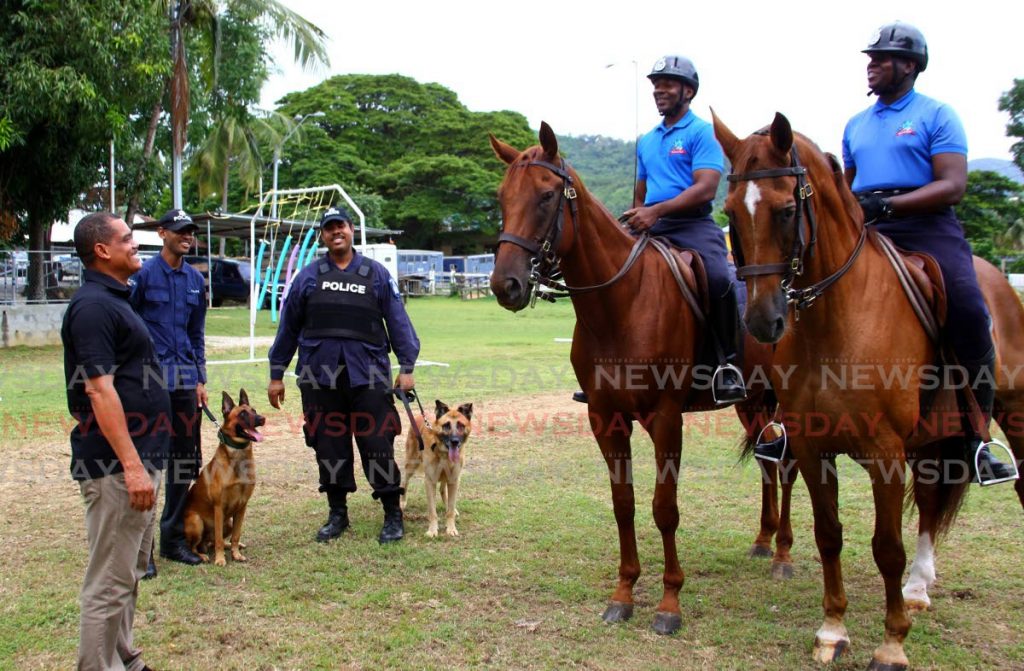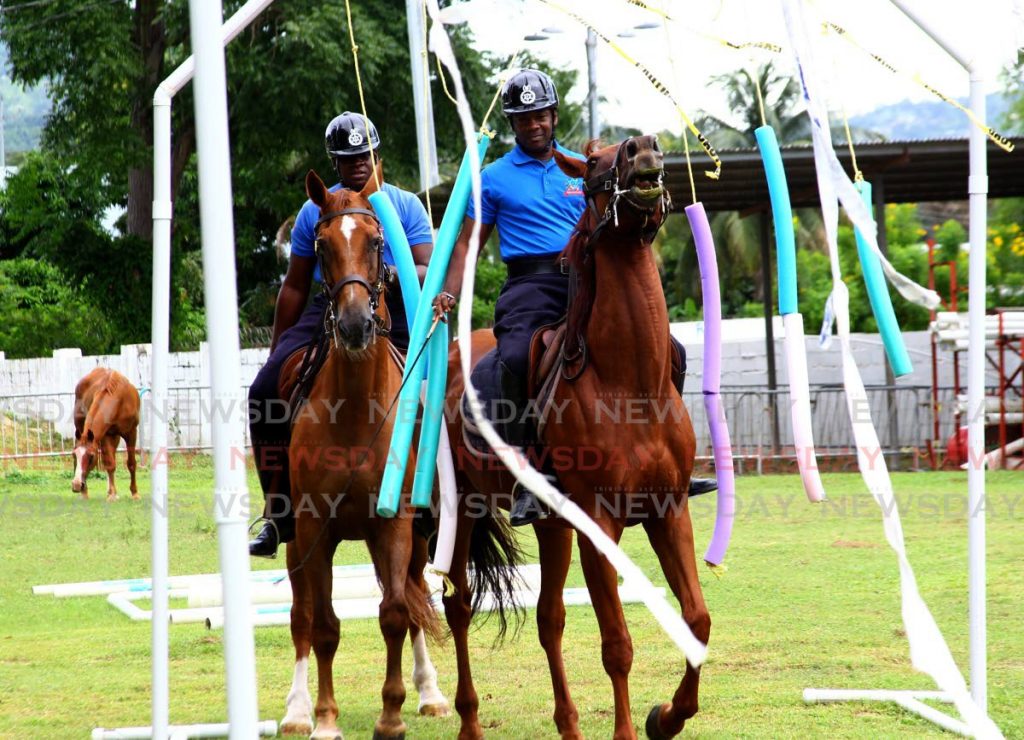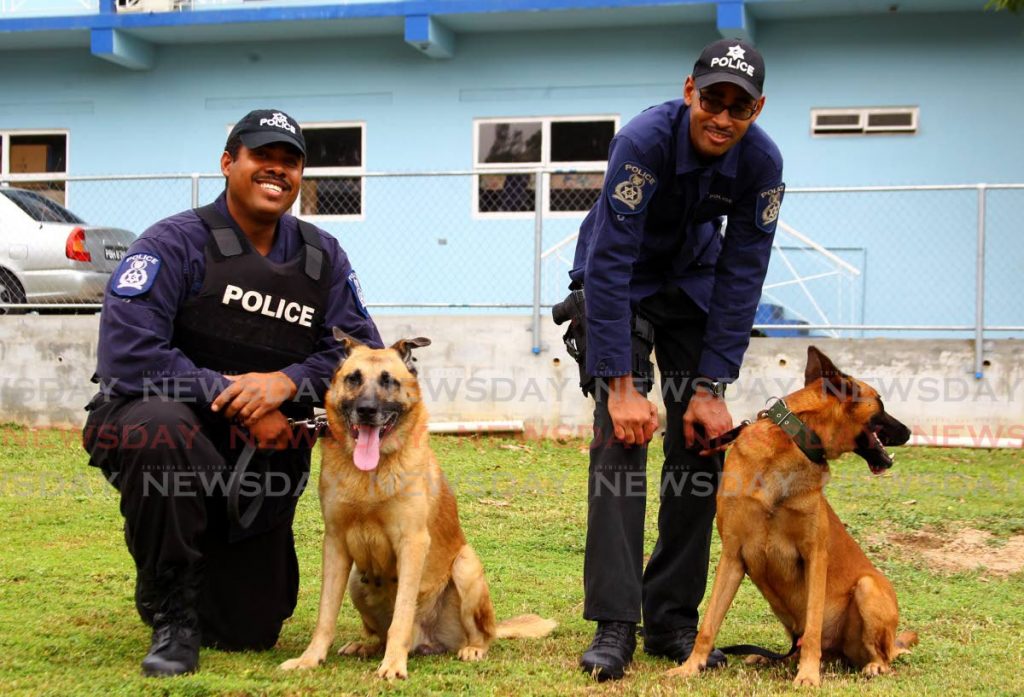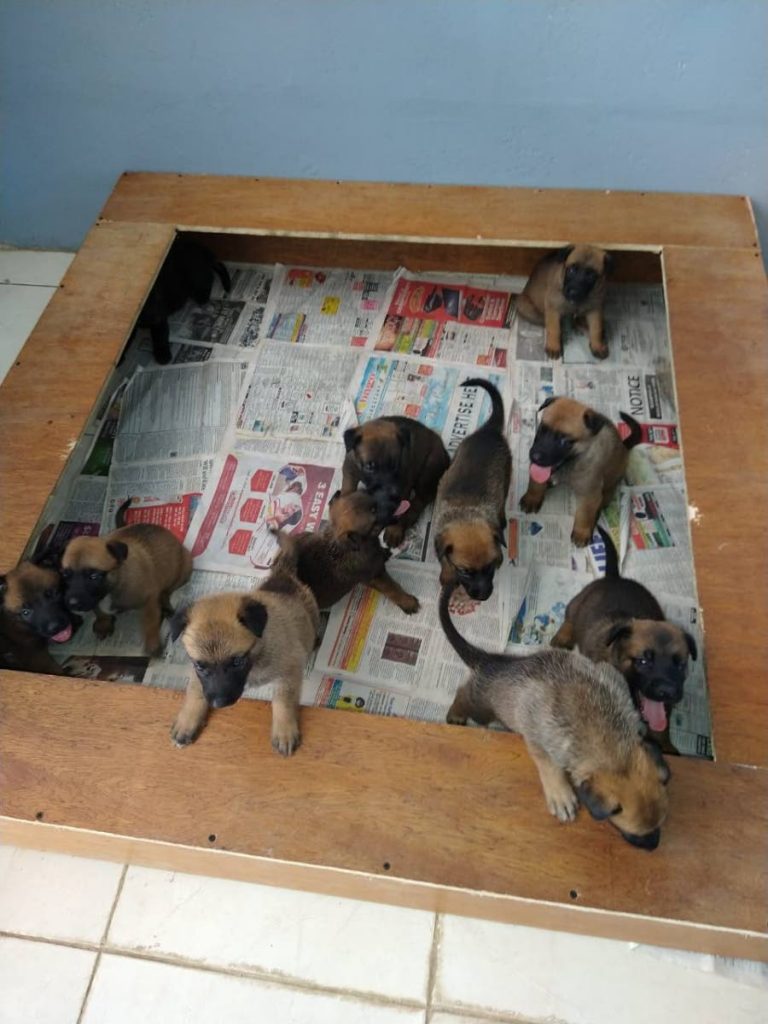Animal cops help communities in ways beyond crime fighting

For centuries, horses and dogs have been valuable assets to law enforcement agencies which have used their abilities to fight crime.
Like their human handlers, the role of these animals has changed from serving strictly on the frontlines to being used as a resource in community policing initiatives through school visits and outreach programmes.
Speaking with Sunday Newsday at the police Mounted Branch and Canine Unit, Long Circular Road, St James, on October 30, Snr Supt Geoffrey Hospedales spoke about where his unit fits in a modern police service and what two of man’s oldest best friends have to offer the communities they serve.
“The mounted and canine units are important parts of the police service because of the functions we perform.
“The effect the horses have on people in the community is overwhelming.”

This is best observed during Carnival when police horses are frequently deployed to events as a means of crowd control, despite this children and adults are drawn to horses and can be seen petting them.
Recognising the potential of horses in bridging the gap with communities they serve; the police have launched a series of programmes involving the members of the Mounted Branch, most notably free riding lessons to special needs children.
Hospedales said the programme which has been in operation for over 20 years is coordinated by retired police officers and has yielded some positive results.
“The horseback riding lessons are a means of calming the children and getting them to respond positively.
“Sometimes a horse may be shy or have certain reservations about riding around obstacles but you would be surprised how well that same horse would respond if it is being ridden by a special needs child.
“It’s a special kind of effect the horse and the child have on each other.”
This bond is one Hospedales said he himself has experienced during his time with the unit over the past year.
Despite being a relatively recent addition, he notes the soothing effects of interacting with the animals.
“Because of what I’ve seen while I was here, I have learned to ride horses. I’m still in the closing stages of my training but I would have learned to ride and learning to ride and being a mounted officer myself, you see the effort an officer puts in.
“Before coming here, I had minimal knowledge of this section of the police service, just what everyone else sees.
“Being here you see there’s a lot more going on than what goes on, on the outside. You have to take care of the animals. The riders, the handlers themselves have to take care of the animals so you develop a bond with the animal.”
This bond, he said, is important for both the officer and their animal co-worker in a job that is both physically and emotionally taxing.
The horses which are imported from Holland undergo a ten-month training period where they develop the trust and bond with their riders, an important aspect in any effective partnership.
With 35 horses including an additional ten received in January, the officers and their animals are involved in routine patrols, crowd dispersal exercises, ceremonial duties and more recently therapeutic work.
For their partners in the canine arm of the unit, work tends to be more straightforward as they are directly involved more in crime-fighting operations but still have the potential to be used as emotional support animals.
At present, the unit has 48 dogs with different designations from finding narcotics, dead bodies, explosives and guns to confronting and apprehending criminals.
According to Hospedales, police dogs have assisted in finding over $7 million in drugs last year and he believes they have found much more this year.

“The success rate of these dogs is very high. They are called out to work on exercises almost every day and work just as hard as their human handlers.”
Last month it was reported that a police dog led officers to a water tank in Aranguez where two bandits were hiding.
The bandits who shortly before broke into a warehouse hid the items, they stole in a nearby dirt track which was also found by the dog.
Stories like these are not uncommon for the canine unit as they are accustomed to the role dogs play in fighting crime.
In the past dogs were sourced from breeders in the US, but an initiative launched before the covid19 pandemic sought to re-introduce a local breeding programme to be done in house at the police kennels.
Hospedales said the initiative is more convenient and cost-effective and the puppies born from this programme are the first generation of locally-bred police dogs in decades.
For police dogs training begins at the tender age of two months where they are introduced to their trainers and taught the basics of obedience.
Trainer Cpl Chase said this stage of a dog’s life is important in developing the basic skills necessary for life as a police dog.
“At this point in their training it’s like dealing with a baby so we try to utilise positive reinforcement as much as possible.
“We make sure to encourage the puppies as much as possible so that every interaction they have is a positive one.”
He said as the dogs mature, they are assigned to handlers when they taught everything including detection skills, criminal apprehension and tracking.
“During this phase of training the dogs really distinguish themselves as to what the skills of these dogs are, whether for narcotics, firearm or explosives detection or they can be used as cadaver dogs to help find bodies that have been hidden.”
The dog breed of choice for the police is the Belgian Malinois, renowned for the temperament, strength, agility and intelligence.

Unlike their cousins the German Shepherds, Malinois are less prone to hip injuries as they grow older making them an asset as working dogs.
While they can be overlooked for their ability to help in law enforcement, one officer knows firsthand the potentially life-saving abilities of police dogs.
Four years ago, Insp Raphael Mohammed was part of a search party for a missing person in Toco.
During the exercise, Mohammed and his team got lost and had to rely on the abilities of his cadaver dog to find their way back.
“I lost my way and at night in the forest everything looked the same, I lost all my sense of bearings, so I unclipped my dog from his leash and followed him right back to where we started without giving him any commands.
“He wasn’t trained for that particular purpose but I knew dogs had a way they could retrace their steps by way of scent and I just trusted him.”
Mohammed, who has been with the unit for the past ten years of his 25-year-long police career said he feels at home among his co-workers both human and canine.
“I wouldn’t ask to go anywhere else. It has been extremely fulfilling being a canine officer.
“I was a canine handler then a canine instructor and now being part of the administration at the middle management level. It's the ideal career for me.”
Unlike the horses, there are no therapeutic programmes involving police dogs however Hospedales said the animals are used for school visits and public demonstrations.
“A lot of people don’t know what dogs are capable of so seeing a dog jump and demonstrate its ability are surprised when they see what they can do.”
The use of horses and dogs has grown since their introduction to local policing in 1952, and while some might see them simply as resources, to their handlers at the Mounted Branch and Canine Unit, they are valued friends and colleagues.


Comments
"Animal cops help communities in ways beyond crime fighting"